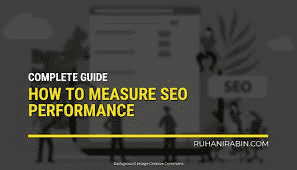What is the most effective way to measure SEO performance?

Search Engine Optimization
The objective of search engine optimisation (SEO) is to make your web pages appear high in search engine results. If your content is relevant to your product or service, it should appear at the top of search engine results. SEO also attracts quality traffic to your website, so it is so effective.
An inbound marketing strategy must include a digital presence, whether you’re a freelance photographer or party supplier. By choosing an SEO strategy that works, you can boost your website’s visibility, grow organic traffic, and attract new customers.
How Do You Measure SEO?
The first step in evaluating the performance of your SEO strategy is knowing your numbers. If you’ve spent more than five minutes in SEO, you’ve probably heard that adage, “What you measure, you move.”.
You can track hundreds of metrics. According to Google’s algorithm, there are over 200 ranking factors. Initially, you should focus on just a few. Track the metrics that are most important to your business regularly.
Organic Traffic
When users type a question, a word, or a string of words into a search engine, they will receive a list of related ads and pages. The number of visitors to your site that comes from organic search results is the number of people who click through your web pages after discovering them through search engines.
Organic traffic from organic search is the best website traffic because it’s targeted. To gain a new subscriber or customer, you must offer solutions that meet the client’s needs. It’s a good indicator of your SEO strategy. An increase in organic search results means more visibility for your website through keyword rankings.
Take a look at our Domain Overview and Traffic Analytics tools to see how your website compares to your competitors. Using both can help you better understand your organic traffic and how your audience interacts with your site.
You’ll find a high-level overview of your traffic, including organic and paid traffic, in the domain overview. It lets you see up to five competitors.
Keyword Ranking
A keyword encompasses anything that a user searches for in a search engine. When a single word or phrase produces a page of results on Google or another search engine, it is considered a keyword. Your website and content need to be optimised to rank high in search engine results for specific and long-tail keywords for this metric to work.
Doing a Google search for your business or product-related keywords is a simple way to keep track of your Google ranking. Your website will appear in the search results based on that keyword’s competitiveness. Since more than 25% of people click on the first Google search result, the ultimate goal is to get on the first page of Google and as close to the top as possible.
A keyword gap analysis can help you better understand your keyword performance and discover new relevant searches. Using up to five competing URLs, we help you identify which keywords you are ranking well for, which keywords you are not, and which keywords your competitors are earning search engine rankings for but that you may still be able to earn rankings for.
SERP Visibility
Google answers every search query by producing a search engine result page (SERP). SERP features include organic results, ads, and sponsored results. SERPs include featured snippets (instant answers), knowledge panels, and image packs.
The visibility of your website in search results is affected by the authority of the SERP features, which is determined by how many people see it. Nevertheless, this metric provides you with a clear picture of your SEO progress.
With the Position Tracking Tool of the SEO toolkit, you can quickly check how visible your website is. To help you outline your content, we offer a featured snippet feature that identifies the opportunity to rank for featured snippets based on specific keywords and shows you what the current featured snippet looks like.
Click-Through Rate
The click-through rate (CTR) represents the percentage of users who clicked on your website from the search engine results page. Suppose your site was listed on a results page 100 times a week, and ten people clicked on it. Your CTR would be 10%. You can use this metric to gauge how effectively your title tags and meta descriptions catch users’ attention.
Featured snippets can be good for your business if you optimise your meta descriptions, titles, and URLs. Don’t be discouraged if these metrics are low; it just means you need to optimize your meta descriptions, titles, and URLs. There is an average click-through rate of 28.5% for positions 1 through 5 on Google. The result is an increase in your click-through rate and your keyword ranking.
Open Google Search Console to see your click-through rate. “Search Traffic > Search Analytics” is located on the left-hand side of the screen. Then, you’ll see checkboxes titled “Clicks,” “CTR,” and “Impressions.” Click on “CTR” to see your average click-through rate and the top-performing pages and keywords.
Bounce Rate
You measure the percentage of users who visit your site and leave without engaging further in the bounce rate. Visits that include more than one click in Google Analytics are considered interactions. In a nutshell, it assesses a visitor’s quality.
Each type of website has a different benchmark bounce rate. If your lead magnet, content, or website layout is not appealing to your target market, tracking your bounce rate can help you identify this.
You can check the bounce rate of your domain by a device (mobile or desktop) and see if there has been a recent improvement by viewing the last six months, past year, and all-time data using our traffic analytics tool.
Conclusion
With the metrics and SEO tools you have at your disposal, you can start tracking the results of your efforts. It’s probably clear that SEO rankings take a lot of effort. And even once you achieve the top, the work doesn’t stop.
FAQs
Why do we need to measure the success rate in SEO?
To prove the value of SEO, SEO professionals track everything from rankings to conversions to lost links. Your SEO success, retention of clients, and perceived value depend on measuring the impact of your work and improving it continually. Measuring results helps you pivot priorities when something doesn’t work.
What is a KPI in SEO?
Marketing teams use SEO KPIs to measure the performance of their website in organic search results.





